Introduction
In times of globalisation, migration is a key factor which affects the economies of countries on all continents. People who migrate to another country, usually for permanent residence, bring more than their skills to their host country (Peri & Requena-Silvente, 2010). Their experience, their knowledge of and their connections to the country of origin can be a stimulus for the market in the host country. In the following, migrant enterprises are defined as commercial companies that are fully owned by a person (or persons) with an immigrant background. They represent an important potential for the development of trade relations between their countries of origin and the host country, especially since migrants are often active as dealers or sales agents (BMZ, 2013).
In the last twenty years many empirical studies have been conducted on the impact of international migration on international trade. This study focuses on changes in the corporate structure of the economy concerning exports. As an example, the development of the economy of Burgenland, the eastern region in Austria, from 2005 to 2015 with a focus on the current status is examined. This federal state had Objective 1 area status in the European Union.
This study focuses on the Austrian province Burgenland because this region was the one that was most affected by the improved access to Eastern Europe due to its geographical location. During the last five years, exports rose most in Burgenland among all Austrian provinces (+ 35.7 percent). In comparison, the average of all Austria’s federal states was 20.2 percent. During this period, more than 16,500 people from abroad settled in the observed region (Burgenland.at/Statistik Austria 2016).
According to the Austrian Economic Chambers, the institution represents more than 450,000 member companies; more than 20,000 are based in Burgenland. For operators in the industrial economy membership is compulsory. The rules on how to obtain a trade business license are set out in the Trade Act (Gewerbeordnung – GewO). Austria has benefited in recent years by regional political changes and the economy particularly profited from the fall of the Iron Curtain in the northern and eastern part of the country in 1989. In the same year, the Austrian Government formally applied for accession to the European Union. After five years of successful negotiations, Austria joined the EU on January 1st 1995. The internationalisation initiative (Internationalisierungsoffensive) of the Federal Ministry of Science, Research and Economy in cooperation with the Austrian Economic Chamber helps Austrian exporters and investors to remain competitive in the international environment. It was launched in 2003 and a follow-on program is ongoing. The Minister of Trade and Economy announced that 31 million Euros had been invested in the scheme by 2015. Furthermore, the access to self-employment was relaxed by the Trade Act, Gewerbeordnung 2007 (Schmid et al., 2006).
Austria was dominated by the so-called Foreign Migration Model in the decades of the 1960s and 1970s and by refugee migration during the breakup of the former Yugoslavia. A majority of people with an immigrant background are employed. Only a small percentage is self-employed and thus ethnic entrepreneurs (Aigner, 2012). The decision for self-employment is a long-term basis. Therefore, the study also gives an insight on the development in the past 10 years.
The OECD Migration Outlook 2009 cautions that many migrants start businesses in vulnerable sectors, for example in tourism, gastronomy, wholesale and construction. This paper will focus on the sectors in Austria where migrants establish companies and export.
In Austria, two thirds of all employees with a migrant background work in companies which have foreign operations (Schmid, 2010). This paper also addresses the question of whether this situation is exploited by the firms.
Theoretical Framework and Related Literature
Scientists from countries all over the world have investigated the impact of migration on self-employment and the international flow of goods from various perspectives and focusing on different nations.
Vandor and Franke (2016) found in their study “convergent evidence that cross-cultural experience increases a person’s capabilities to recognize particularly profitable types of opportunities by facilitation the application of cross-cultural knowledge for the discovery of arbitrage opportunities and creative recombination.”
Scientists from New Zealand and the Netherlands focused on the international economy. In a meta-analysis, Genc focused on 48 studies that yielded 300 observations. Their results show “that immigration complements rather than substitutes for trade flows between host and origin countries. Correcting for heterogeneity and publication bias, an increase in the number of immigrants by 10 percent may be expected to increase the volume trade on average by about 1.5 percent” (Genc et al., 2015).
What makes a migrant become an entrepreneur? The OECD (2010) turned examined this question and distinguished different types of migrant entrepreneurship. “Some migrants – especially lower skilled – start a business because they lack other employment options while, at the other end of the spectrum, often highly skilled migrants start very successful job-creating firms.” According to O’Reilly (2014), the majority of global migration is driven by poverty, political instability, environmental hazards and lack of job opportunities, but there are also numerous other migrant types, like lifestyle migrants. The term lifestyle migration is used when relatively affluent people move to places which open up the possibility of self-realization or of which they expect a higher quality of life.
A study for the Spanish market found that doubling the number of immigrants leads to a 10 percent increase in export to their country of origin (Peri & Requena-Silvente 2010). They analysed the period 1995 to 2008. Immigrants increased from 1 percent of the Spanish population at the start of the study to 10 percent in the year 2008. The number of exporting firms grew from 58,000 to 100,000. The new citizens mainly came from several different countries in Latin America, Eastern Europe and North Africa. Peri and Requena-Silvente found that the 80 to 100 percent increase in exports was due to new exporting firms rather than to larger volumes exported by existing firms. Peri and Requena-Silvente make two interesting observations: first, “The effect of immigrants in promoting exports from Spain was the strongest towards those countries that are culturally more different from Spain and with lowest levels of development.” Second, “Immigration networks make more a difference for export to those countries that present more severe information and language barriers for the exporters.”
Hettlage (2009) assumes that immigrants who open a business mobilize transnational networks of resources and thus have a market advantage. She analysed 30 self-employed migrants from Italy, Turkey, Sri Lanka and Ex-Yugoslavia who settled in Switzerland. A network analysis showed that transnational relations play a subordinate role which would preclude a high level of export participation by immigrant businesses.
Hout and Rosen (1999) came to the same conclusion: Having a father who owned a business significantly increases the probability of being self-employed, except among immigrants. They conclude that “the migrant effect is stronger than the parent effect.” With regard to the export industry, this would mean that migrants become entrepreneurs because of their economic situation and their business idea. The family at home and connection to the country of origin are of secondary importance.
A study by the Friedrich-Ebert-Stiftung in Germany (Leicht 2014) came to the conclusion that most of the companies of migrant entrepreneurs have a customer base that is not dependent on demand from their compatriots.
In recent years, more and more new social and economic networks across borders have been created and there are improved effective and low cost communication and transportation links (Leicht, Langhauser 2014). Both these factors can be interpreted as stimuli for exports.
Methodology
Secondary data from the Austria Economic Chamber and Statistics Austria are used for this analysis. These data are used as they are objective, reliable and up to date and are available for to the author as a staff member of the Economic Chamber Burgenland, although some are publicly available. The focus is on the number of entrepreneurs, the distribution of firms in different sectors, the nationality of the entrepreneurs and the number of immigrated and emigrated people in Burgenland. The analysis was performed in Excel and SSPS. The focus of interest is the relationship between established migrant businesses and exports in Burgenland.
To test the research question ”Is there an influence of companies founded by migrants on the export economy of the host country?” 2 hypotheses were formulated:
H1. The export share in the respective target country is higher, if more people with this nationality live in the export country.
H2. Migrants are mainly self-employed in sectors which are focused on customers and the market in the host country.
The aim of this study is to investigate the impact of migrants’ companies on the export sector of the Burgenland economy.
Study Results
The proportion of foreign entrepreneurs in Burgenland in 2005 was 3.9 percent, in 2010 it was 24.6 percent and five years later in 2015 foreigners represented 38.3 percent of all commercial entrepreneurs. In 2005, the migrant entrepreneurs came from 38 countries, from 48 countries in 2010 and from 67 countries five years later.
Compared to 2005, entrepreneurs from the newly-represented countries Afghanistan, Bangladesh, Chile, Japan, Latvia, Niger, Nigeria, Portugal, Taiwan, Tunisia, USA, Venezuela and Vietnam founded a company in the year 2010.
In 2015, entrepreneurs came from the countries Armenia, Australia, Belarus, Belgium, Colombia, from the Dominican Republic, Ecuador, Finland, Georgia, Iran, Iraq, Island, Kosovo, Kyrgyzstan, Lithuania, Moldova, Nepal, the Philippines, Samoa, Syria and Thailand for the first time. Entrepreneurs from Afghanistan, Chile, Congo, Lebanon, Niger, Spain, Taiwan and Vietnam that set up businesses in 2005 or 2010 had disappeared from the market by 2015. The highest increases in immigrant entrepreneurs since 2005 were of Romanian citizens followed by (in descending order) people from Slovakia, Croatia, Hungary, Tajikistan, the former Yugoslavia, Slovenia and the Czech Republic.
H1. The share of exports to the respective target country is higher, if more people with this nationality live in the exporting country, i.e., in Burgenland.
Looking at the main export destination countries, a different pattern is evident. The most important business partner is Germany, followed by Hungary, Italy, Switzerland, China, United Kingdom, Slovakia, Sweden, Poland and France in descending order (Figure 1).
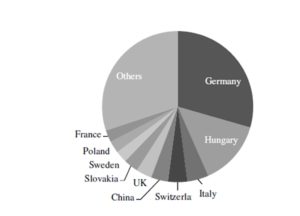
Fig 1: The top 10 export destinations of Burgenland by value in 2015
Source: Statistic Austria 2016
But, who are the foreign entrepreneurs in Burgenland? How many migrants of each nation are self-employed in the federal state? Nations with a great growth of migrant companies in Burgenland from 2005 to 2015 are according to WKO Statistics: Romania (+15,732%), ahead of Slovakia (+3,953%), Croatia (+2,833%), Hungary (+1,174%).
To rate the employment of migrants, it is necessary to make a comparison of the various nations as Figure 2 shows. The phenomenon that there are more entrepreneurs than citizens from Romania (self-employment rate 125%) in Burgenland can be explained by a change in the trade regulation act (Gewerbeordung) in 2007, affecting the legal conditions for the personal care sector. The official name of the sector is “people advice and support” (Wirtschaftskammer Wien, 2016) and in this sector immigrants work in Austria only for some weeks or months. If they are in Austria more than a half year in total or they come back the following year, they are counted as an entrepreneur, and their business license remains valid. The proportion of Romanian entrepreneurs is especially high in this sector. In Burgenland, 4% of the local population are entrepreneurs. They have the same self-employment rate as the citizens of France, Slovenia and Switzerland in Burgenland. The citizens of Romania, Croatia, Hungary, Slovakia, Bulgaria, Poland, the United Kingdom, the Czech Republic, Italy and Germany show a higher self-employment rate than local people (Figure 2).
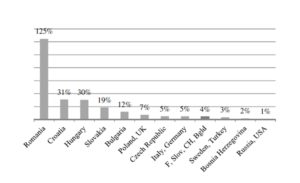
Fig.2: The percentage of entrepreneurs among citizens of foreign Origin in Burgenland 2015
Source: Wirtschaftskammer Burgenland 2016
Testing the database (Wirtschaftskammer Burgenland, 2016) shows that all three data sets are non-normal. Entrepreneurs have a distribution that is furthest from normal. It has the lowest value of the test statistic, W, as indicated in table 1.
Table 1: Shapiro-Wilk normality test – Exports/Immigrants/Entrepreneurs 2015
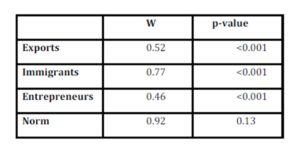
Source: Wirtschaftskammer Burgenland, own calculation
Table 2: Pearson product-moment correlation, R with significance levels 2015

No asterisks, NS; *, p<0.05; **, p<0.01; ***, p<0.001.
Source: Wirtschaftskammer Burgenland, own calculation
Table 2 shows that the number of immigrants is correlated with both, the level of exports to the source country and to the number of entrepreneurs from that country present in Burgenland. This correlation gives good results for normal data, but as shown in table 1 the data here have been shown to be non-normal.
Table 3: Spearman’s rank correlation with significance levels 2015

No asterisks, NS; *, p<0.05; **, p<0.01; ***, p<0.001.
Source: Wirtschaftskammer Burgenland, own calculation
The correlation between immigrants and exports to the source country disappears when one uses a correlation statistic used for non-normal data. The Pearson correlation for this pair of variables is likely affected by outliers in the data, particularly Germany and Hungary. Using the Spearman statistic shows that there is however a significant correlation between immigrants and entrepreneurs. It is difficult to know how important this finding is, because one might expect such a correlation if the number of entrepreneurs from a country are drawn from a pool of immigrants from that country, i.e. if the one variable is a subset of the other. A complementary view of the sector data gives specific insight.
H1. The export share in the respective target country is higher, if more people with this nationality live in the export country. The first hypothesis must be discarded.
Table 4 shows which sectors of the Economic Chamber of Burgenland have more than 10 percent of entrepreneurs from a nationality other than Austrian. Sectors that can be considered international are highlighted in gray.
To answer hypothesis 2 – Migrants are mainly self-employed in sectors which are focused on customers and the market in the host country, it is necessary to analyse in which sectors the foreign entrepreneurs are active.
The percentage of foreign entrepreneurs is the highest in the sector of people advice and support. The legal framework for this branch of commerce was only created in 2007. Almost half of the entrepreneurs in the chemical industry and cleaning sectors are migrants. Only the businesses freight transport industry (30.0%), print (21.2%), foreign trade (18.8%), mail order, Internet trade and general distribution (14.5%), car trade (14.2%) and trade in fashion and leisure time products (10.2%) are related to exports.
Migrants are mainly self-employed in sectors which are focused on customers and the market in the host country. Hypothesis 2 is confirmed. This finding is similar to that of earlier work (Hettlage 2009).
Table 4: Sectors with Percentage of Foreign Entrepreneurs in % 2015
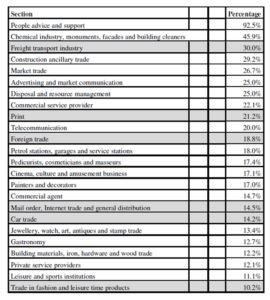
Source: Wirtschaftskammer Burgenland 2016
Comparing the Export Orientation of native and foreign entrepreneurs in Burgenland shows, between 4 and 5 percent of the businesses are engaged in exports – in both groups.
The answer of the research question ”Is there an influence of companies founded by migrants on the export economy of the host country?” is: Migration companies deal mainly with sectors that are less relevant for export.
Discussion
This study is a status quo of 2015 and a broad view of changes over the past decade.
Research limitations
An important influence on assessments and forecasting is the political situation and the level of economic development in the countries of origin of the migrants. On the one hand, there are peaceful home countries, for example as in Romania and Hungary, where the majority of migrant entrepreneurs in Burgenland come from, and on the other hand, there are countries with armed conflicts like Syria and Afghanistan. In the observation period 1946-2006, empirical analysis shows that armed conflicts last 7 years on average. It takes 22 years for a nation to overcome the consequences of a war (Berger et al., 2016). Another aspect is the legal and economic conditions in the host country. Is it possible for migrants to integrate into the economy of a country? Are there facilities for access to professions? Are there businesses where entrepreneurs with a migrant background can and will succeed? An example is the increased influx of Romanian nursing assistants after legalization of their profession by an amendment of the Industrial Code in 2007.
Migrants often start their firms alone or as “networks of trust” with their family. In the next generation some of them will be employer establishments (Wahlbeck, 2007); therefore, long-term studies are necessary to make scientific statements with forecasting ability concerning start-up intensity and export duties.
There is another argument for continuing observations over a longer period: foreign operations fluctuate over the years. Another aspect should be considered: The OECD (2010) considers fictitious self-employment. People are classified as self-employed, but they are often only hired occasionally, part-time, or they act as seasonal entrepreneurs.
It is interesting to look at the population of working age, the export quota and the self-employment rate in the country of origin of the various migrants of interest.
A comparison of the percentage of population at working age, the self-employment rate and the export rate of the 10 nations whose immigrants are numerically most important in Austria, shows that an approximately similar level can be seen between the first two values, population and self-employment rate. In contrast, the export ratio varies greatly (Figure 3). The export orientation is obviously a factor which is influenced by the conditions in the host country.
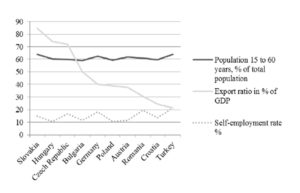
Fig.3: The percentage of the population of working age, export activity and self-employment rate in the countries with the highest immigrant Representation in Austria, 2015
Source: Wirtschaftskammer Österreich 2016
Conclusion
The country of origin of migrants has become more heterogeneous in recent years. The largest increases are of migrants of Eastern European countries, particularly from the new EU member states. This should apply to the German-speaking countries in general, as a study by the Federal Ministry of Economics comes to the same conclusion in Germany (Jung et al., 2011). The study shows that the service sector is increasingly important for migrant businesses. In comparison, the export sector is less affected by migration.
An analysis of the database of the Economic Chamber of Burgenland shows that over the last decade there is a correlation between exports and migrants and between migrants and starting a business. But migrants’ companies mainly focus on the market and its niches in the host country and are less focused on using contacts in their country of origin to start economically important changes in the export sector. Between 4 and 5 percent of migrant start-ups are engaged in foreign trade as the entrepreneurs of the observed region. Migrants orientate their attitude and business activity according to the conditions in the host country.
The factors influencing internationalization are numerous. According to Loisch (2006), these include environmental characteristics, organizational conditions, attitudes and personality traits of the management, business objectives and corporate strategies. It would also be interesting to learn more about the trade barriers that migrant companies face in their activities. Results from such studies would offer approaches for management consulting in the source countries (BMZ, 2013).
Research on the link between export orientation and export performance shows the strategic importance of investing in entrepreneurial orientation (Martins Marques de Lima Rua et al., 2016). The Austrian Federal Economic Chamber with its partners offers mentoring for migrant entrepreneurs. In the present author’s opinion, this project would be a possible object of study concerning the impetus of the export sector, not only to collect data, but to develop a vision.
Requirements for future studies
Further studies will be necessary to extend the results to other regions and to investigate other aspects, like the sizes of exporting companies, the duration of business activities, the flow of commodities and the qualification of the operators, to get a more comprehensive picture of the migrants on the economy of their host country, for example, in Austria or other Objective 1 regions of the European Union.
The experts of the Max Planck Institute for Demographic Research recommend a regular global survey of migration (World Migration Survey), where data of the countries of origin, the countries of destination and transit countries are collected (Willekens et al., 2016). The impact of migration on the flow of goods and other economic effects would be an important related question.
(adsbygoogle = window.adsbygoogle || []).push({});
References
- Aigner, P. (2012), „Ethnic Entrepreneurs“ in Austria, Series „IMP Working papers on Migration, Integration, Diversity“, ISBN 978-3-902877-00-0, 6-8, http://migrationstudies.at/ Ethnische_Unternehmen_Austria.pdf.
- Berger, J., Biffl, G., Graf N., Schuh, U., Strohner, L. (2016), Ökonomische Analyse der Zuwanderung von Flüchtlingen nach Österreich, Schriftenreihe Migration und Globalisierung, 11.
- BMZ Bundesministerium für wirtschaftliche Entwicklung und Zusammenarbeit (2013), Migration und nachhaltige Wirtschaftsentwicklung, Berlin, Germany: Deutsche Gesellschaft für internationale Zusammenarbeit (GIZ) GmbH, 10+48.
- at (2016) based on Statistik Austria, Bevölkerung nach Staatsangehörigkeit. [Online], [Retrieved August, 7, 2016], http://www.burgenland.at/fileadmin/user_upload/Downloads/ Land_und_Politik/Land/Statistik/Menschen_und_Gesellschaft/Bev%C3%B6lkerung/T5_Bevoelkerung_nach_Staatsbuergerschaft.pdf.
- Federal Ministry of Science, Research and Economy (2016), Internationalisation Initiative. [Online], [Retrieved July, 22, 2016], http://www.en.bmwfw.gv.at/ExternalTrade/Internationalisation_ Initiative/Seiten/default.aspx.
- Genc, M., Gheasi, M., Nijkamp, P., and Poot, J. (2011), The impact of immigration on international trade: a meta-analysis, Norface Migration, Discussion Paper No. 2011-20, norface-migration.org.
- Hettlage, R. (2009), Ethnic Business – Global Trade?, terra cognita – Schweizer Zeitschrift zu Integration und Migration, 15, 44-46. http://nbn-resolving.de/urn:nbn:de:0168-ssoar-334145.
- Hout, M., and Rosen, H. (1999), Self-employment, Family background and Race”, NBER Working Paper 7344.
- Jung, M., Unterberg, M., Bendig, M., and Seidl-Bowe, B., (2011), evers & jung by order of Federal Ministry of Economy, Hamburg, Germany: evers & jung, 1 – 4.
- Leicht, R., and Langhauser, M. (2014), Ökonomische Bedeutung und Leistungspotenziale von Migrationsunternehmen in Deutschland, Bonn, Germany: Friedrich-Ebert-Stiftung, 68.
- Loisch, U.C. (2006), Organisationskultur als Einflussgröße der Export Performance, Wiesbaden, Germany: Deutscher Universitätsverlag, GWV Fachverlage GmbH, 9.
- Martins Marques de Lima Rua, O.M. and Santos Silva Franca, A.M., (2016), “Linking Entrepreneurial Orientation to Export Performance”, Journal of Entrepreneurship: Research &Practice, Vol. 2016, Article ID 169418, DOI: 10.5171/2016.169418
- O’Reilly, K., for bpb.de, Bundeszentrale für politische Bildung (2014), Was ist Lifestyle Migration? [Online], [Retrieved July, 25, 2016], http://www.bpb.de/gesellschaft/migration/kurzdossiers/ 198238/was-ist-lifestyle-migration.
- OECD (2009), OEDC International Migration Outlook, Paris.
- OECD (2010), “Entrepreneurship and Migrants”, Report by the OECD Working Party on SMEs and Entrepreneurship, OECD, 4-5.
- Peri, G., and Requena-Silvente, F., (2010), Do immigrants create exports? Evidence from Spain [Online], [Retrieved June 30, 2016], http://voxou.org/article/do-immigrants-create-exports-new-evidence-spain.
- Schmid, K. (2010), Außenwirtschaft und Humanressourcen, Herausforderungen infolge der Internationalisierung, ibw-Forschungsbericht , No. 152, Vienna, Austria: ibw, 3.
- Schmid, K., Mandl, I., Dorr, A., Staudenmayer, B., Haberfellner, R., (2006), Entrepreneurship von Personen mit Migrationshintergrund, Studie im Auftrag des AMS Österreich, Vienna, Austria: AMS Österreich, 5.
- Vandor, P., and Franke, N., (2016), See Paris and… found a business? The impact of cross-cultural experience on opportunity recognition capabilities, Journal of Business Venturing, Volume 31, Issue 4, 388-407.
- Wahlbeck, Ö. (2007), “Work in the Kebab Economy: A Study of the Ethnic Economy of Turkish Immigrants in Finland“, Ethnicities, Vol. 7 No. 4, 543-563.
- Willekens, F., Massey, D., Raymer, J. and Beauchemin, C., (2016), “International migration under the microscope”, Science, Vol. 352, Issue 6288, 897-899, cited by Max Planck Institute, [Online], [Retrieved August 9, 2016], http://www.demogr.mpg.de/en/news_press/news/press/ htm.
- Wirtschaftskammer Burgenland, (2016), Mitgliederstatistik, Auswertung nach Nationalitäten.
- Wirtschaftskammer Wien (2016), Personenbetreuung – Betreuung in vertrauter Umgebung, [Online], [Retrieved August 9, 2016 form October 10, 2011], https://www.wko.at/Content.Node/branchen/w/Personenberatung_Personenbetreuung/Personenbetreuer/Informationskampagne:-Personenbetreuung—Betreuung-in-ve.html
- WKO Statistics, (2016), Länderprofile weltweit, Wirtschaftskammer Österreich. [Online], [Retrieved August 2, 2016], https://www.wko.at/Content.Node/Interessenvertretung/ ZahlenDatenFakten/Laenderprofile_weltweit.html.
25.WKO Statistics, (2016), WKO working for your company. [Online], [Retrieved July 22, 2016], https://www.wko.at/Content.Node/wir/Austrian_Economic_Chambers_Home.html.









